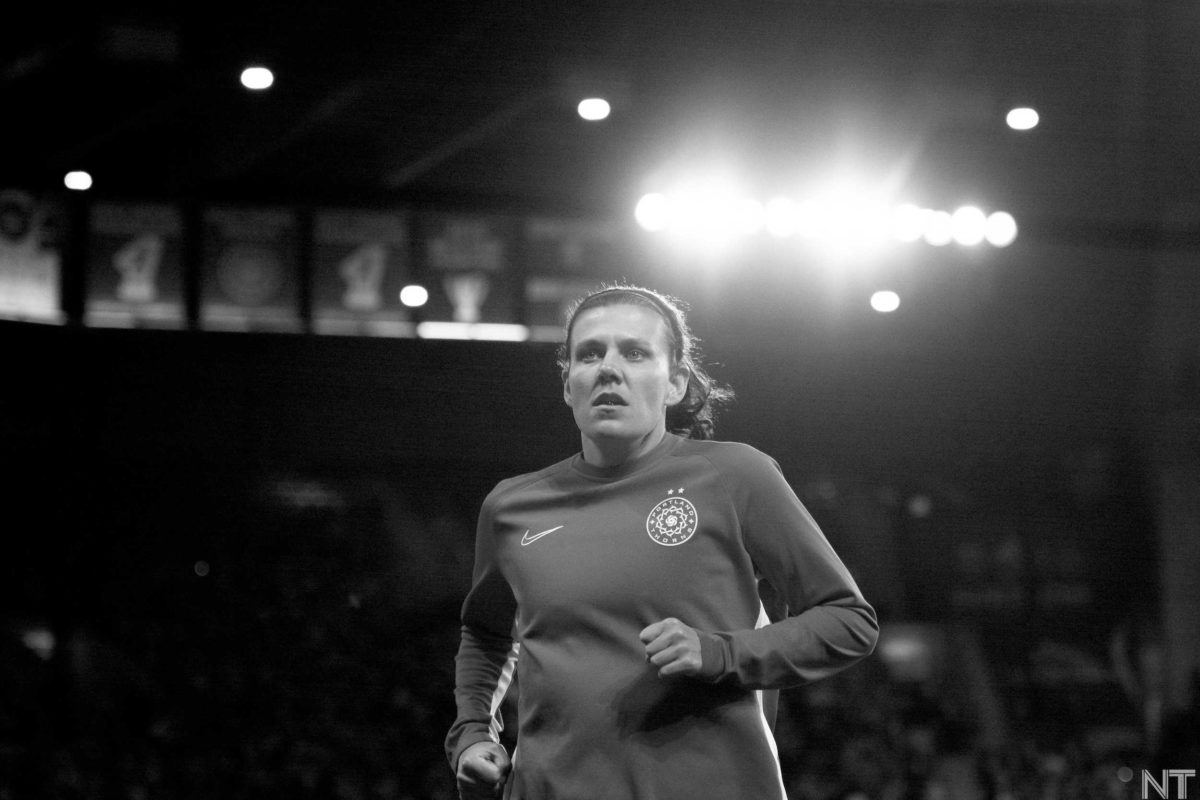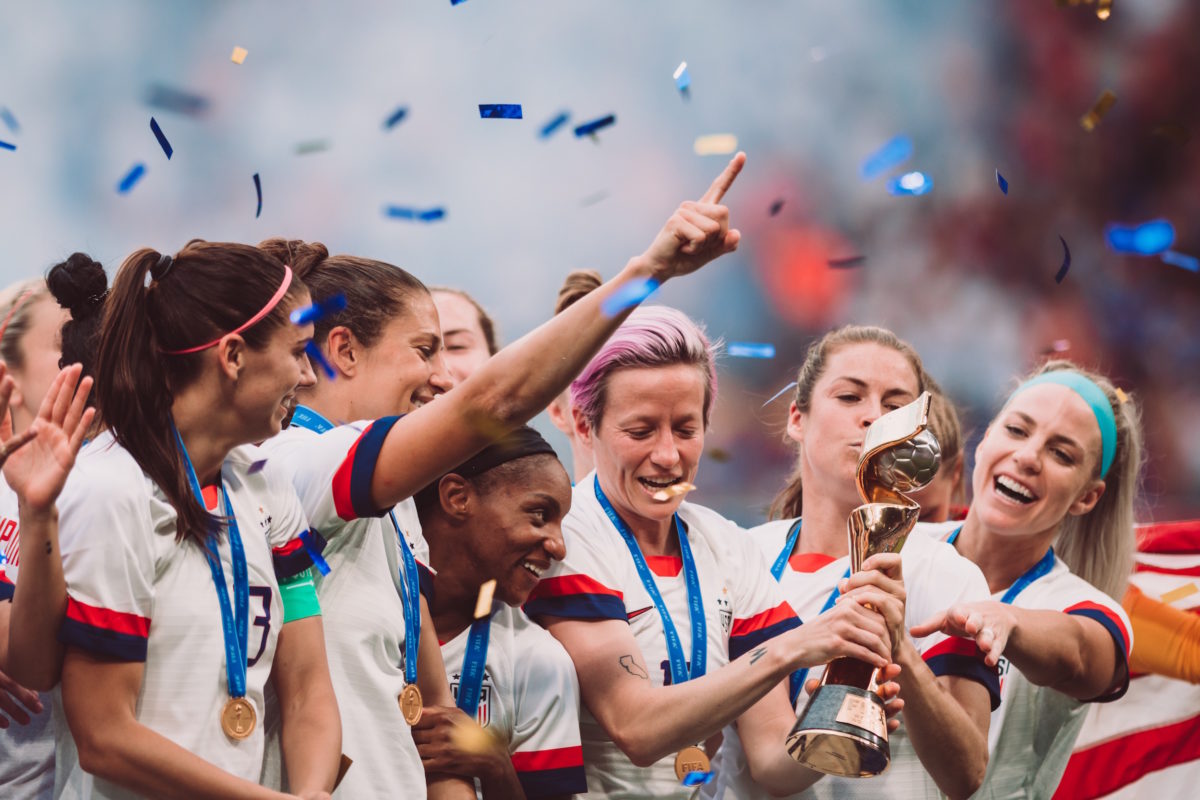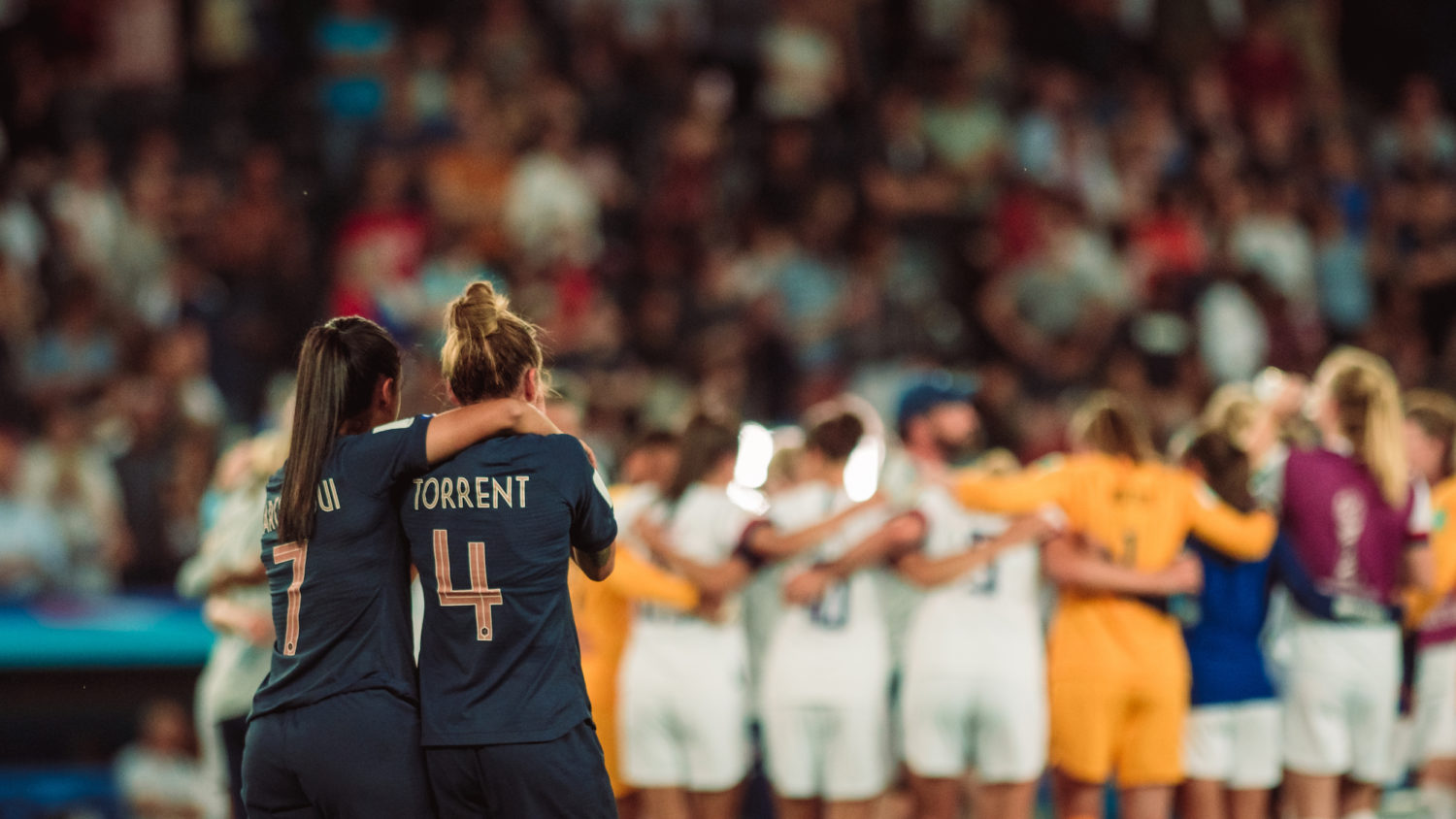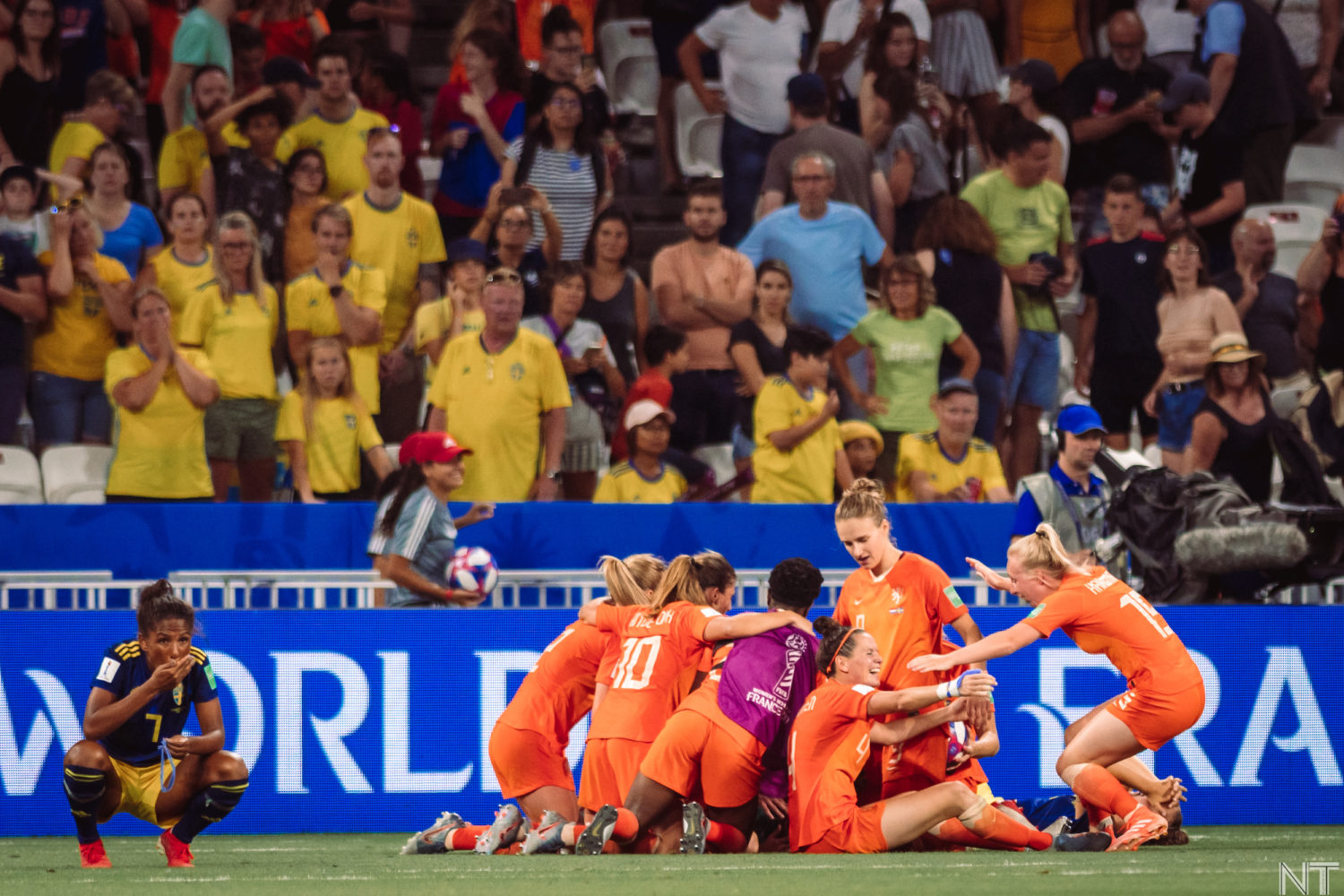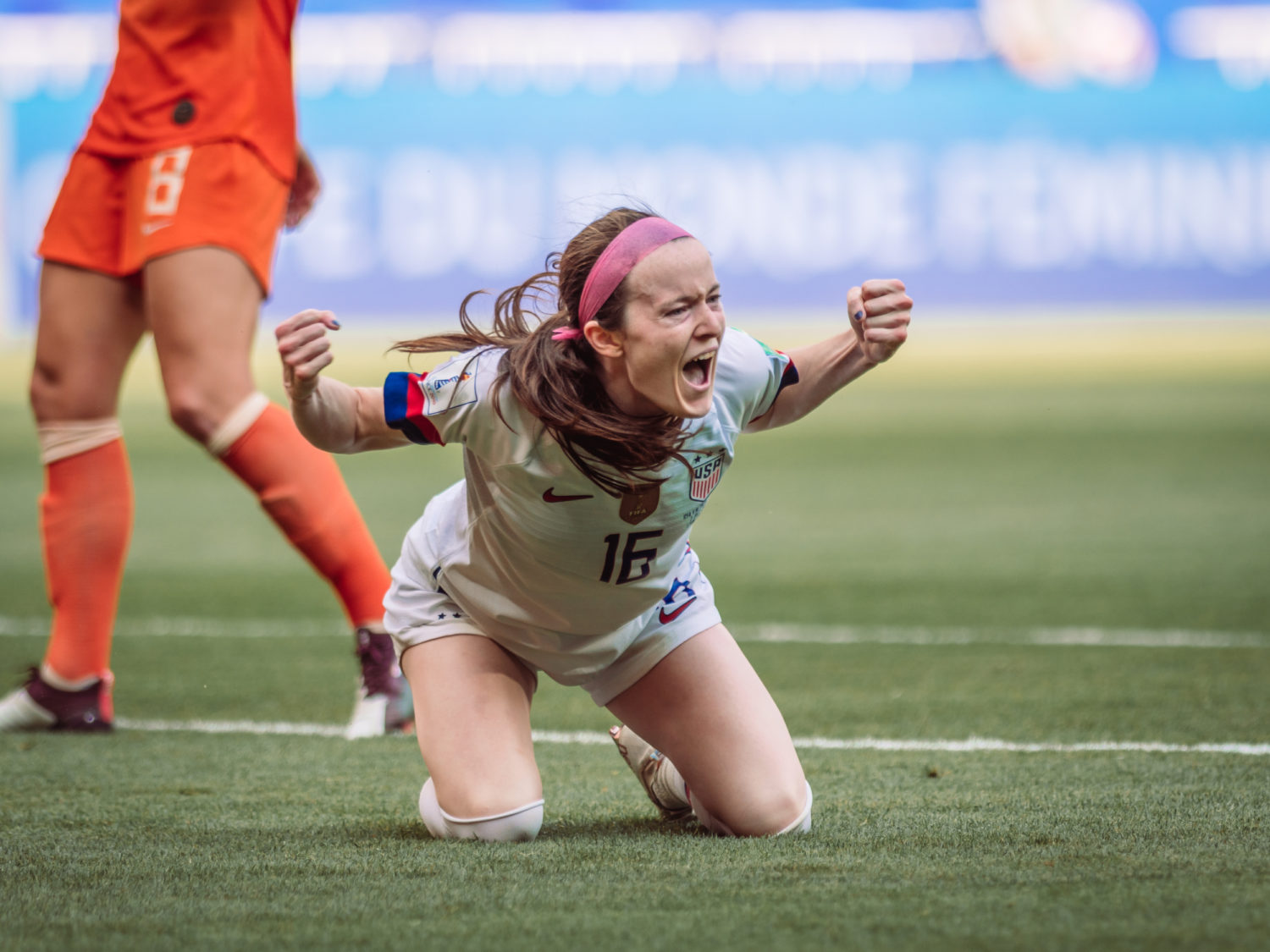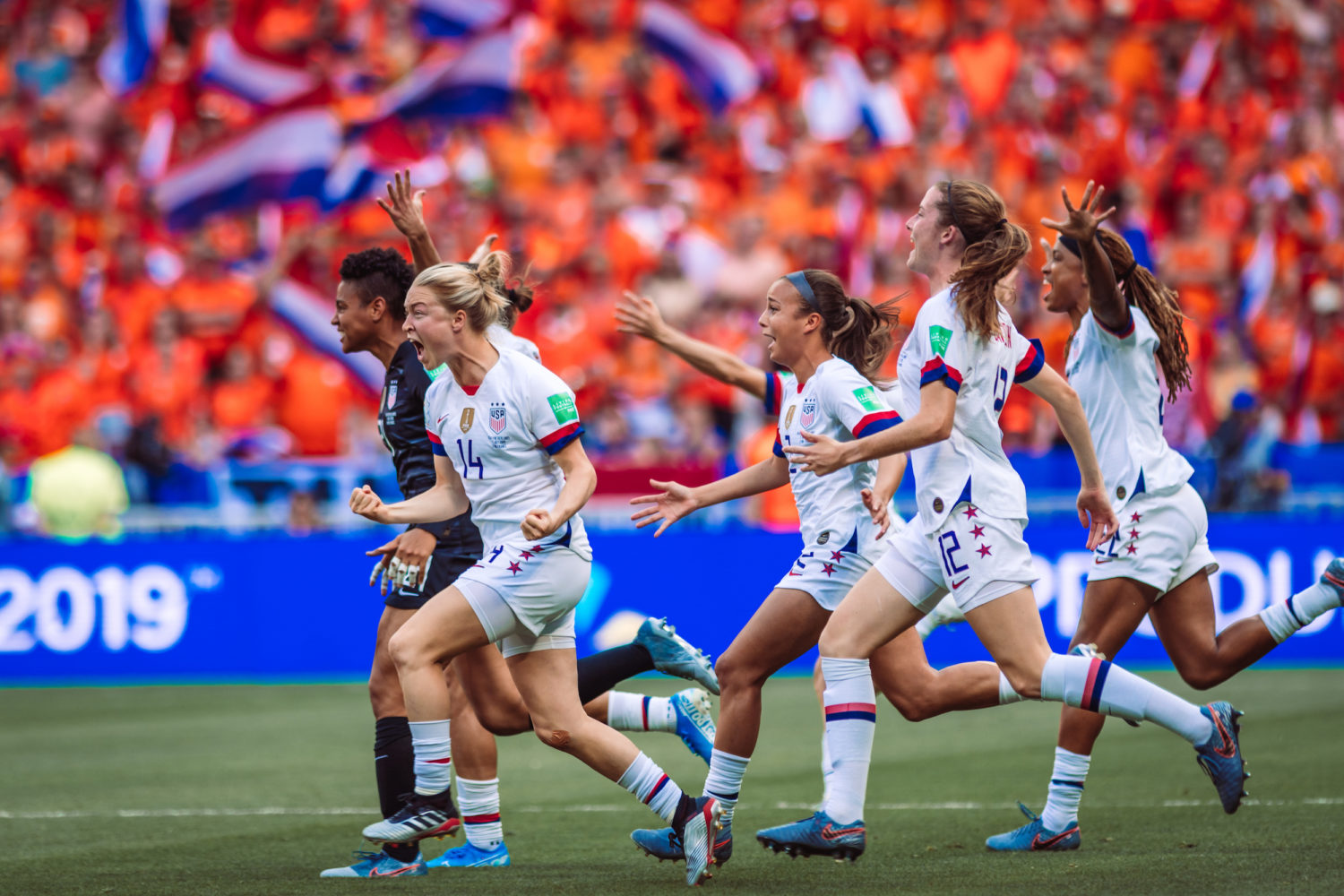Ed. note: this article originally appeared in the June 2019 print edition of Howler. Since the time of publication, obviously, certain facts, including the one big fact, have changed. We have presented it unedited. Enjoy!
Stripped down to its essential components, soccer is an incredibly simple game. The point is to put the ball through a specified rectangle of air, delineated by a set of goalposts, more times than the other team. So if you want to define who the best soccer players are, there’s one easy, reductively simple answer: they’re the ones who score the most goals.
Which means that at the international level, the best player of all time is retired American forward Abby Wambach.
Wambach scored 184 goals in her 256 caps, which works out to just over .7 goals per game. She scored her first on April 27, 2002, in a friendly against Finland, and her last on August 19, 2015, in a World Cup victory tour friendly against Costa Rica.
On the field, Wambach was a striker’s striker, about as pure a target woman as they come, her game centered around pace, athleticism, and strength. She was a masterful header of the ball, making what should be a blunt instrument look like a finely honed weapon, using it to score over and over, often in spectacular fashion. Off the field, she could be brash and occasionally guileless, epitomizing, both as a person and a player, the rah-rah ethos of American soccer: run fast, jump high, and never, ever give up.
It’s a curious thing, then, that just below her on the list of top international goal scorers is a soft-spoken, self-effacing Canadian named Christine Sinclair, a player who represents, existentially if not quite athletically, Wambach’s exact opposite.
Sinclair is quiet where Wambach was loud, shrinks from attention where Wambach has cheerfully done the cable talk circuit, leads by example where Wambach was known for curse-filled pump-up speeches. Sinclair is, well, Canadian. And if she breaks her American colleague’s record, she will likely stand in perpetuity as, by the most literal definition possible, the greatest international soccer player of all time.
Canada Soccer once sent out a tweet reading simply:
Christine Sinclair
It was probably an accident, but as with so many great inventions, that doesn’t diminish its perfection. Those two words, and the negative space left by all the words that are absent, capture everything you need to know about Sinclair, which is that she’s a player so good and so far beyond reproach that her name itself is content. It also perfectly encapsulates what she is to Canadian soccer, which is to say: everything.
I.
Canada, of course, that frozen expanse to the north, is a hockey country. This is important for our purposes for several reasons.
First: like the United States and Australia, Canada is a country whose women’s soccer team ranks much, much higher in the global pecking order than their men’s team (those countries’ men rank 25th, 42nd, and 79th, respectively, while their women rank first, fifth, and sixth). That all three of these countries are members of the wealthy Global North whose citizenries have quite different sporting obsessions than the rest of the world is probably not a coincidence when it comes to women’s soccer—these are countries with resources to put into girls’ and women’s sports, where girls tend to be pushed out of more culturally significant athletic pursuits and into soccer.
Second: in women’s soccer, the difference in quality between the top few teams and everyone else is much, much starker than on the men’s side. Picture men’s and women’s soccer as separate landmasses. One has a nice, broad continental shelf extending out into the ocean, while the other ends in a sheer underwater cliff dropping straight into the abyssal zone. In this metaphor, on the women’s soccer continent, the United States is on land, while a handful of others, including France, England, Australia, and Canada—the only teams that can realistically hope to challenge the Americans in any given match—are fighting it out on a narrow beach.
That relates to Canada being a hockey country in that even though the Canadian women fall into that narrow shallow zone, they are still well below the level of the top-ranked USA. There’s a long-lived rivalry between the two neighbors, but it’s an extremely lopsided one, mainly significant in that it tends to bring out bad blood on both sides. The last time Canada won was in 2006; the two teams have faced each other 25 times since.
All this is to say, first, that Christine Sinclair would only have been possible in a few countries on earth, but more importantly, that she has personally made Canadian soccer what it is.
Christine Sinclair is related—she’s not sure exactly how—to Canadian Prime Minister Justin Trudeau (“His mom is like, my dad’s great-aunt or something like that,” she says). I’m not sure if there’s a family resemblance, but it’s easy to squint a little and convince yourself there might be. They have the same dark hair, the same bright blue eyes.
They met once, in the run-up to the 2016 Olympics, when the team was in Ottawa, and Sinclair reported being surprised that Trudeau knew who she was. The team posed for a group photo with the Prime Minister on Parliament Hill, and she gave him a jersey with his name on it.
II.
If you ever happen to meet the Canadian captain, don’t tell her that (the part about personally building the Canadian national team, not the Justin Trudeau thing). She’ll deny it, and when she does, it won’t be out of false modesty, or even genuine modesty, but real pride in her teammates. And of course, saying she’s done everything herself is hugely hyperbolic, and does a disservice to a lot of very good Canadian players. The plain fact, though, is that Sinclair is by far the best soccer player Canada has ever produced.
To be clear, I mean much more that Sinclair, who would be a legend regardless of what country she came from, is good than I mean that Canada isn’t good. It’s just that coming from where she comes from, she elevates her team in a way someone like Wambach, playing alongside a half-dozen other players deserving of various superlatives, never did.
The game that best illustrates what Sinclair is to Canadian soccer is their semifinal loss in the 2012 Olympics against—who else?—the United States. It’s the game that Sinclair herself identifies as the moment women’s soccer arrived in her homeland. “Looking back on it,” she told me, “it’s probably the first time that Canadians truly, like, cared about how we did.”
It’s not hard to see why it had that effect. Played at Old Trafford, the game was an instant classic, the two teams trading goals until literally the last minute before the final whistle of extra time.
“We waited a long time to be able to compete with the Americans on that stage,” Sinclair remembers. “To have Canada finally reach that level and be able to hold our own against the number one team in the world, blow for blow.”
What she would never point out herself is that she’s the one who scored all three of Canada’s goals, very nearly sending the game to penalties and making her one of just three players1 to ever score a hat trick against the United States.
She opened the scoring in the 22nd minute, running onto a lateral flick from Melissa Tancredi, taking one deceptively simple, perfect touch as she charged forward and beat Rachel Buehler, then another as she cut right around Kelley O’Hara. With her third touch, she threaded a shot expertly between a diving Hope Solo and the far post—her 141st career international goal.
Early in the second half, Megan Rapinoe equalized (with a fucking olimpico, of all things), and for the next 40-odd minutes, it was all-out war. Sinclair put Canada up again, then Rapinoe equalized a second time, then Sinclair put Canada up a third time. After a controversial penalty put away late in regulation by—who else?—Abby Wambach, the game headed to extra time with the two teams level 3-3.
Finally, in the 123rd goddamned minute, Alex Morgan took advantage of a moment of indecision by keeper Erin McLeod to head home a cross by Heather O’Reilly. The whistle blew. Canada’s gold medal hopes were over.
In the American soccer mythos, that final goal is remembered as a moment of classic USWNT heroism. A game that almost ended in heartbreak, saved in the final seconds because the gals just wouldn’t give up.
It’s all horribly predictable. The American women have won like this so many times, in so many big moments. In a movie version of the tournament, with the USA as the protagonists, you’d write it exactly like this, and critics would say it was a little on the nose.
I would also be remiss if I didn’t note that the officiating in this game was infamously one-sided, so I’ll unpack exactly what I mean by “controversial penalty.” It was the result of a questionable handball call when Rapinoe kicked an inside-the-18 free kick directly into Marie-Eve Nault. That free kick, in turn, was awarded for a bizarre time-wasting call against McLeod—after Wambach had spent the half counting out loud within earshot of the referee. There was also the missed handball call against Rapinoe earlier in the game, which I won’t get into.
For Canada, of course, the loss was crushing. But there were two positives:
- They went on to beat France and win bronze.
- Back in Canada, that vast, wild land where hockey reigns, four million Canadians saw Christine Sinclair score a hat trick against the US, and they saw how close her team came to beating the best in the world, and they began to see this tall, powerful woman as a national hero.
1As far as we know; there are two games where the US conceded at least three goals, against England in 1985 and against the Netherlands in 1991, for which we have no information on who scored (thanks to Jen Cooper for the stats).
Christine Sinclair has a Pomeranian named Charlie. She comes from a small-dog rescue near Portland, where she originally bore the name Cocoa Puff, something her owner says she “never envisioned [herself] calling a dog.” The name Charlie is a tribute to Clive Charles, the legendary University of Portland coach who played for the NASL Timbers with two of Sinclair’s uncles and led her college team to a championship in 2002. Sinclair would win a second championship with UP in 2005, two years after Charles’s death from prostate cancer.
Charlie’s favorite activities are eating, sleeping, and socializing.
III.
Although being among the best in the world at a thing obviously requires innate ability, talent isn’t what anyone mentions when they talk about Sinclair. They talk, instead, about how she has always—in every moment she spends working on being a soccer player—dedicated herself to doing things as well as she possibly can.
“I love that I’ve had the opportunity to watch her,” says Mark Parsons, Sinclair’s head coach with the Portland Thorns, “because if I hadn’t, I would have thought Sinc was born to do this. And by seeing it, you realize this was man-made. This was all about her purposeful practice, her dedication, her preparation, her commitment. When other players missed the recovery, she’s doing recovery. When other players missed evaluating, watching films back, or practicing the shot [they] missed, when they miss it and they’re like ‘oh, it doesn’t matter, I’ll get it the next game,’ she’s doing [those things.]”
Sinclair’s training habits are a study in the pursuit of mastery. Like a concert violinist who spends an hour a day playing open-string exercises, or an Olympic weightlifter who practices snatches and clean-and-jerks with a broomstick, she has never stopped focusing on the most basic building blocks of her craft.
Thorns teammate Emily Menges described this to me. “We do touches sometimes for practice and it’s this close,” she said, standing a few feet away. “Little touches. It’s easy to be like, ‘this is boring, whatever,’ but every single one of her touches is absolutely perfect… Maybe I take a first touch and that’s what I’m worried about, is my first touch… But she’s very much like, ‘here’s my first touch, and then I have to make sure Emily has a good touch.’”
This meticulous focus, day after day, year after year, is what has made Sinclair one of the best of all time, and it has also probably contributed to her longevity as a player.
Comparing Sinclair with Wambach purely in terms of scoring rates, there’s a tortoise-and-hare dynamic. Wambach had a 14-year international career; this is Sinclair’s 19th year representing Canada. Sinclair started earlier, getting her first cap at just 16, and despite now being the age Wambach was when she retired, shows no sign she’s ready to hang up her cleats.
By this point in her career, Wambach had just taken a few months off from her club, the Western New York Flash, supposedly to focus on preparing for the 2015 World Cup—it was never clear why she didn’t consider the best preparation for a big soccer tournament to be actually playing soccer—and, perhaps as a result, showed up in Canada in what counted for her as very poor form2. Meanwhile, Sinclair has kept training and playing as she always has, and has stayed absolutely central to both the Thorns and the Canadian national team.
Several years ago, age started to take a toll on Sinclair’s sprinting speed, but where a lesser player might have kept grasping at the style she played at age 23 only to start slowly fading into obsolescence, she adapted her game, dropping into the number ten slot for both club and country. She still scores, but where before she preferred to charge toward goal at full speed, today she sits between lines and sets up her teammates with a final, immaculate pass as often as she shoots.
That positional shift has slowed down her scoring rate somewhat, but she’s still chipping away, inching ever closer to the record—and it’s arguably made her an even more essential piece than before for both club and country. It’s in part because she is perfectly content to step back, literally, from the front, that she has stayed one of the best in the world for so long.
2It has to be said here that not training or playing regularly with a team for eight-odd months and showing up to a World Cup capable of playing international soccer at all is still an incredible athletic achievement, one that says a lot about how good Wambach was.
Christine Sinclair is on a postage stamp. Designed for the 2015 World Cup, it also features Canada teammate Kadeisha Buchanan and Japanese keeper Ayumi Kaihori. Menges, her Thorns roommate on road trips, found out about this while the Canadian captain was recording an episode of a podcast called Arrow Living produced by Kendall Johnnson, another former Thorns teammate. It’s a wonderful scene. Johnson reads a list of Sinclair’s many awards and accomplishments, and when she gets to “you got a postage stamp of your face in 2015 for the World Cup,” Menges says, “no way!” in the background. A few minutes later, Menges announces she has bought her friend’s stamp on eBay. She still has it.
IV.
If Sinclair beats Wambach, her record will likely stand in perpetuity. To understand why that is, consider the fact that the top eight international goal scorers are all women. Iran’s Ali Daei, with 109 international goals to his name, is the only man with at least 100, a club that currently includes 16 women. Remember the two continents, one gently sloping into the sea, the other a rocky, craggy landmass surrounded by churning ocean?
Although both Wambach and Sinclair are among the very best to ever step onto a soccer field, the enormous volume of goals they have scored has as much to do with those rocks and crags—with the uneven, sometimes bizarre geography of women’s soccer—as it does with their skill as players.
Scorelines that are more or less unheard of in men’s soccer are fairly commonplace in women’s soccer. In the CONCACAF World Cup qualifying tournament this past fall, for example, the USA and Canada each won at least two games with scores of six or more goals to none; Canada beat Cuba, who did not score a single goal in the tournament, 12-0. Both Sinclair’s and Wambach’s goal tallies—along with those of Mia Hamm, Kristine Lilly, Birgit Prinz, and many others—have had a big boost from those kinds of matches over the years.
The other factor to understand is that this kind of drastic inequality is shifting, if slowly and often painfully. A couple decades ago, the continent of women’s soccer was a tiny island; only a handful of countries even fielded teams, and those countries got enough of a head start over everyone else that they dominated the sport for years.
It’s because of this incremental but steady growth in the women’s game that no one is likely to come anywhere near 184 ever again. That World Cup qualifying tournament was a fluke for Canada’s schedule (somewhat less so for the US, whose federation is still happy to throw some real cupcakes into the mix of the dozen-plus friendlies they play each year); outside of official CONCACAF tournaments, where Canada is a big fish in a tiny pond, they’ve only won by more than two goals twice in the last three years. There is still a huge amount of inequality in the women’s game, but the federations that regularly field women’s sides now have enough real competition that there’s no reason to schedule friendlies against teams they’re going to drop a half-dozen goals on.
In 2017, Christine Sinclair was awarded the Order of Canada, her country’s second-highest civilian honor, something her Thorns teammates refer to as “getting knighted.” They learned about the award without any help from the woman who earned it.
“My teammates are dorks,” explains Sinclair. “They’re like, ‘do we have to call you queen now?’ So I try and keep those things quiet from them. I’d just hear about it all the time.”
V.
If you were to list the most important facts about Christine Sinclair, in order, her goal tally would probably be third on the list. The two facts battling it out for the top spot would be as follows:
- Is one of the best soccer players of all time
- Is an almost unbelievably nice person
Sinclair has earned the right to brag, to yell that she’s the best, to take selfish shots when she gets the chance. But if she was the kind of person who did those things, she would not be in the position she’s in.
Life—in sports, under capitalism, in nature at large—is a horrifically unfair endeavor. Success is determined as often as not by sheer random chance, and the rest of the time, the thing is fucking rigged.
In this context, Sinclair’s story has an almost religious resonance. Here is this person who got where she is by years of diligent hard work, by playing for everyone except herself, by care and kindness for the people around her. She is never arrogant, she hates the spotlight, she dotes on a little rescued dog named Charlie. She is outstandingly good. She is the kind of person you hope your children will be when they grow up, and not because she’s a world-class athlete.
In a few months’ time, this person could well be—by the most objective measure possible—the best soccer player in the history of the world. The possibility of this small, nice fact coming true makes our big and broken world seem a tiny bit less dark, in that way that soccer occasionally can when it fulfills its most noble aspirations.
Because she is who she is, Sinclair hates talking about the record. She sees it as a distraction, something that will mess with her game if she allows herself to think about it. Nonetheless, when reporters ask her about it, which we always do, she is unfailingly polite. As of a few years ago, she would always say that she didn’t know how many goals she had, something everyone around her believes to have been the truth.
Being just six goals away from Wambach, she can no longer block out that knowledge completely. She knows exactly where she stands. When I asked Sinclair if she cared about the record, she took a long pause. “I mean, I think so. I’m this close,” she said. “Yeah, I think it would be, like, a shame not to at this point… Just one of those things that nobody could take away from you.”

